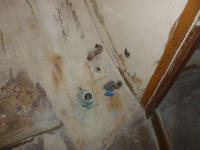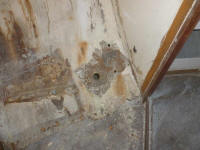
110 Cookson Lane | Whitefield, ME 04353 | 207-232-7600 | tim@lackeysailing.com
After an interesting week, it was a good day to wind down with a few smaller jobs, mainly geared towards my immediate goal of working on surface prep in the interior of the boat.
There were three old through hull fittings in the head, plus one abandoned one, and none of these would be reused in the project. Removal was straightforward. For the two smaller ones, I was able to unscrew the through hull's securing nut enough to allow me to saw through the through hull below the nut, after which it was a cinch to push the remnants out through the holes.
The larger through hull featured a glassed-in reinforcement block, which also covered the flange of the seacock's valve body. I found that although the reinforcement appeared permanent, it was easy to remove my chiseling off the tabbing, which pulled away easily, taking the block and remnants of the through hull with it. Similarly, I easily peeled off the abandoned reinforcement block between the two smaller fittings, and while I was at it removed some semi-shattered adhesive/filler that had been part of the head platform support originally.
Later, I'd permanently patch these holes.
There was an old water tank beneath the starboard settee, and with removal of a couple dozen screws I could remove the settee platform, exposing the tank beneath.
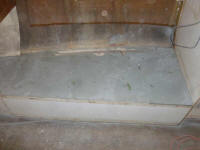
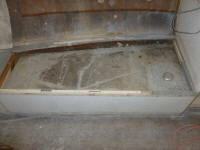
The tank wasn't secured at all, other than within the confines of the space, and at first I figured I'd be able to pull it straight up and out. However, various cleats and obstructions prevented this, so I removed the short vertical panel on the inboard edge, which fortunately was straightforward by removing just eight exposed screws.
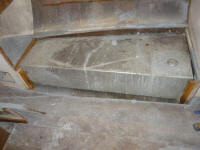
I removed one additional vertical cleat, and pulled out the water tank. Afterwards, I reassembled the settee, as having the platform in place was convenient for working in and around the space.
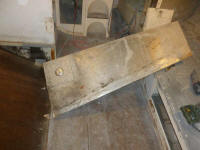
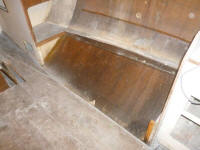

Next, I removed the remaining chainplates. By prying off the light fiberglass encapsulation, a simple matter with a chisel, I could remove the forward and aft lower chainplates on each side (I'd already remove the port aft lower the other day).
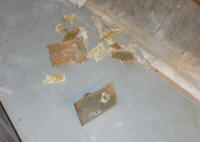
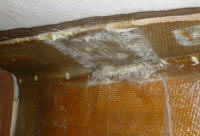
The upper shroud chainplates were the traditional type, vertical plates secured through laminated knees with several bolts. On each side, all the bolts came apart easily, except for one on each side refusing to budge and requiring cutting to remove. Once the bolts were out, the chainplates were easy to remove.
Starboard

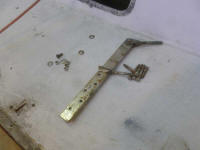
Port
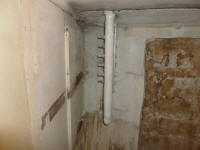
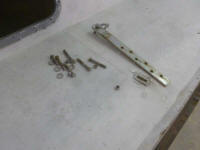
The starboard knee appeared sound, though I'd investigate more later, but the port side had some obvious problems and would require work. Probably related to the various repairs and trauma that had occurred on this side of the boat in the past, some of the fiberglass in and around the area was loose enough to start to pry away. There was a visible gap a the bottom edge of the tabbing, and although I'd leave this job for another day, it seemed obvious that this knee would require replacement.
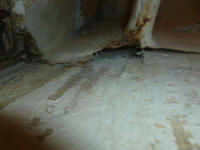

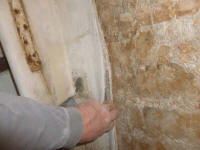
Over the past couple weeks, I'd noticed a small amount of liquid dribbling from a crack on the leading edge of the rudder skeg. While not alarming, I was interested to see that the liquid was depositing a styrene residue stalactite on the rudder where it was dripping off. This deposit was about an inch long at the time of the photo, with the beginnings of a corresponding stalagmite on the floor beneath.
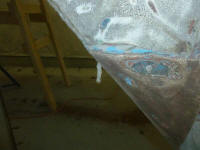
In a task somewhat out of context, I removed and prepared for shipment the original spreader bases from the mast. During mast disassembly a few months after the boat arrived on site in 2011, I'd noted that one of the spreader bases was badly cracked, necessitating replacement. With ancient and worn spreaders, my rigger and I decided that new bases and spreaders were required.
With other, unrelated jobs in the works and their pieces and parts headed off to a custom fabricator, we determined it was a good time to send Snow Lily's as well, so I removed the spreader bases from the mast, taking advantage of a pleasant, warm (for February) afternoon. The arrows show the cracks in question.
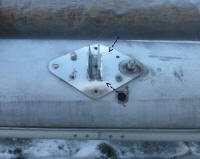

The bases were secured with a rivet or two, several round-head machine screws, and a few hex-head machine screws (and several holes with no fasteners at all), a typical amalgamation found on poorly-maintained older boats. Fortunately, the fasteners all came out without issue, though I did discover that the aluminum sleeve that passed through the mast between the two lower tangs (with a through bolt securing it all together) had welded itself to the bolt; fortunately, the entire sleeve could pass out through the side of the mast with the bolt head, but I had to cut the bolt in order to separate the tang and spreader base.
I packaged these up for shipment to the fabricator. The spreaders were already there, as I'd given them to my rigger last fall.

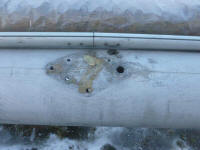
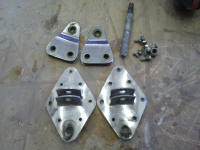
To wrap up the day--and the week--I cleaned up the boat and shop from the week's messes, and prepared some tools and materials for next week.
Total Time on This Job Today: 6 hours
